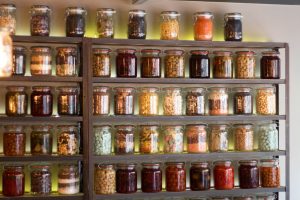For most of us meal planning is something we do to keep the wheels spinning on our household. Typically we are planning a week (or maybe two) of meals for the handful of people that we share a roof with. For me, my meal planning crash course began when I started cooking for several different families in their homes. Most of the time I would create a menu based on recipes I found on the web, write them on a piece of paper and then create my grocery list.
I would scour the internet, searching for recipes that looked tasty, jot down some ingredients and cross my fingers that I had everything I needed when I got home. That was my meal planning life prior to Plan to Eat. Sound chaotic and risky? It was.
Now, I have a bank of recipes that I can easily pull from and plan. I know that meal planning can seem overwhelming at first—it definitely was for me. Now, it is much more streamlined. I will log into my Plan to Eat account, place some recipes on the calendar, and head off to the store to get what I need. It’s usually not very complicated. Finding the recipes and planning them may all happen in a 20-minute time frame, before jetting off to the market.
Do you freeze up when it’s time to plan? Here are my top 5 sites that I import recipes from when I just don’t know what to make!
For myself, and many others, meal planning has become a profession. Our careers range from a health coach working with clients struggling with weight loss, to managing hundreds of meals served at a hospital. This is definitely a more recent opportunity for me, and I wanted to grow my knowledge so that I could plan more effectively and healthfully for my clients.
What meal planning knowledge do experienced meal planning professionals have that newbies may not know yet?
Coincidentally, Cadence Health, a school which offers online nutrition and health coaching classes, approached Plan to Eat a few months ago, asking if we would be interested in partnering with them in their Meal & Menu Planning Course. They use Plan to Eat’s customizable program throughout their course to teach meal planning from start to finish because Plan to Eat allows students (and you!) to tailor plans to suit the specific needs of their clients or families. And I was thrilled when they asked if I wanted to take the class to gain some insight into what the pros know!
I just finished the class, passed the final test, and here are 5 key points that would help us normal people create more healthful meals and become better planners:
- Restrictive dieting doesn’t work.
The class spends a period of time talking about restrictive dieting, which is typically eating less to lose weight, and how it is ultimately not helpful because it is not sustainable. Instead, the class focuses on eating a well rounded diet, which is sustainable. With that, the class shows you how to account for dietary needs or restrictions. For example, if you are dairy-free, you will still need to find good sources of calcium, potassium, and Vitamin D to fill in the nutritional gaps in your diet. That is a simple example of how to supplement a diet that has some limitations.
- Food journals will tell us how we are doing.
Evaluate what you currently are consuming. If you are already planning with Plan to Eat, this is actually really easy. Take a look at your previous weeks or months plan. Are you eating too much starch? Too little protein? Not enough veggies? Over doing it with dessert or maybe eating too few calories? Take a look over your plan and evaluate what your needs may be. Work with what you already enjoy and make it delicious and healthful for you.
- Eating a variety of foods is good for you. Food ruts are not.
I don’t know about you, but I can get stuck in a major food rut. I will eat the same meal everyday for a week. I will do this because I have a busy schedule and I find certain things quick and healthy or easy for me to grab. After a certain point, I usually decide that I should mix it up. It turns out that shaking things up and eating a wide variety of foods is really good for you. This may seem obvious for some of you, but I truly needed to learn this. Be proactive in making sure your eaters are getting a wide variety of foods and food groups in their daily diet. Not only does this aid in nutritional sufficiency, but it will help make meals even tastier.
- Remember that you are not the professional (unless, of course, you are).
If you believe that you or someone that you cook for is sick or have a nutrition deficiency, be sure to take them to a doctor to diagnose them. Though we often want to treat our own ailments, drastically changing your diet can also be harmful to your health!
- Being healthy vs. being healthful
The biggest takeaway was learning to distinguish between being healthy and being healthful. Healthy can sometimes have a negative connotation, since so many diet foods are branded with that word and we are constantly bombarded with what is the next best food for our health. But being healthful is restorative; eating foods that are well balanced, inclusive, and filled with quality ingredients. Even the word makes me feel like what I am cooking is filled with good nutrients, sustaining, and more nourishing. Focus on being healthful and you will be healthy.
Since I completed this course, I have learned how to better gauge the healthfulness of what I am planning for my clients and even for personal life. I consciously look over the details of the current months’ meal plan and check for repetition or imbalances. I will then create a new week of meals that compensates where the plan may be lacking and adjusts for specific needs. If my clients are requesting certain proteins or maybe even lower calorie meals, I make sure that those needs are taken into account.
In my personal meal planning, this has also affected the way I choose my meals. I am a runner and it’s vital to make sure to refuel after a long 7 or 8 mile run or even prepare for the next days workout. I use a food journal to keep tabs on my eating and my goals. I’ve really learned how to look at the bigger picture through the journal. The goal is to be healthy and nourished and Cadence Health helped me learn how tailor plans for my families needs, my personal needs and those of my clients.
Resources and A Note from Cadence Health
“After a great deal of research into meal planning options Cadence Health chose Plan To Eat as its preferred meal planning software. Hands down, it was the most flexible, functional and user-friendly option, and of course the service was excellent. So, you can imagine how thrilled we were when Plan To Eat’s very own Christopher enquired about our Meal and Menu Planning course for Riley. Most of our students are people who are very passionate about healthy eating and about changing people’s lives to improve overall wellbeing. One of the challenging aspects for food and health coaches in working with clients is not simply imparting healthy eating knowledge, rather it’s in providing strategies to encourage positive changes in eating habits; after all we all know that eating an apple is healthier than a cake, but the challenge is sticking with the apple for the long term. Tracking down companies like Plan To Eat for Cadence Health is part of providing training that offers tools for coaches, and students in general, to do their best for their clients and themselves. If you are like Riley, and are keen to learn more about nutrition for you and your family, or if you are one of those people who wants to change lives then check out our internationally approved Certificate of Nutrition & Health Coaching atwww.cadencehealthcoaching.com.au or our general interest nutrition courses at www.cadencehealth.com.au.











